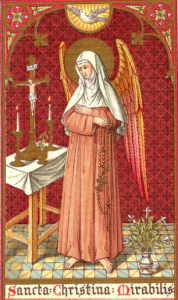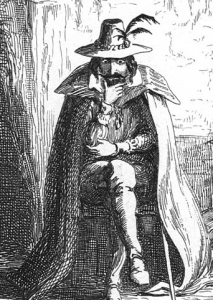It is spooky season, and there’s nothing Catholics do better than chopping up our dead friends and sharing them around. I think it has something to do with belief in the Resurrection; “O death, where is thy sting?” So, I decided to list thirteen saints I like, in order of how severely metal they are.
13. St. John the Divine
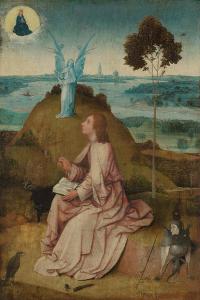
John the Divine, or John the Theologian, was the author of the book of Revelation; he is widely identified (including by me) with St. John the Apostle, though this is disputed. Though it’s pretty confusing to modern audiences, who often lack the background in Jewish apocalyptic theology and imagery that the book takes for granted, I honestly think it’s an artistic achievement of the first order; the structure is elegant, recursive yet avoiding monotony through strategic breaks in its pattern. St. John himself might be higher on this list if he had been martyred, but he’s certainly earned a spot on it by writing Revelation.
12. St. Anthony of Lisbon
Anthony of Lisbon (or of Padua) is best known today as the saint you pray to when you’ve lost something; he was one of the first Franciscans, and famed for his preaching. He makes this list as being a sort of twist on the incorruptible tradition. If you haven’t heard of these, incorruptibles are saints who are found after their death to decay with miraculous slowness, or even not at all. St. Edward the Confessor was one of the first incorruptibles in the West (when he was exhumed two hundred years after his death, he appeared to be sleeping, and the abbot who was in charge of the transfer of his relics had to rebuke one of his monks for tugging the king’s beard!); St. Bernadette, the visionary of Lourdes, is among the most famous. But St. Anthony is a twist, in that he was found incorrupt … but only in his tongue and vocal chords, which were removed for separate veneration, while the rest of his body crumbled into dust.
11. St. Pio
In a list like this, you have to have a stigmatic. The fact that he could read souls, prophesy, levitate, and bilocate does elevate him to an exceptional stature even among stigmatics! He too was a Franciscan; their founder is widely thought to be the first stigmatic (although some interpretations of Galatians 6.17 assign this honor to St. Paul). The blood which flowed from his wounds reputedly smelled sweet, like flowers, and he generally covered his hands with fingerless gloves, even when saying Mass.
10. St. Anthony of Egypt
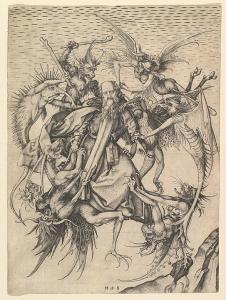
Also known as St. Anthony the Great, he lived from the mid-third to the mid-fourth century, and was perhaps the first Christian to practice the life of a hermit. He lived alone in the desert, where he reputedly spent hours in prayer and fasting, doing battle with demons. Many of his sayings survive, and his life and teaching became a major influence in all subsequent monasticism. The woodcut above, The Temptation of Saint Anthony by Martin Schongauer (executed in the early 1470s), became the basis for an early painting of Michelangelo.
9. St. Januarius
Januarius (Gennaro in Italian) was a bishop martyred during the Diocletian Persecution, around the year 305. According to legend, a woman named Eusebia saved a vial of his blood, which, despite being many centuries old at this point, regularly continues to liquefy to this day. Direct scientific study of St. Januarius’ blood is not possible, as the Church, fearing irreparable damage to the relic, will not permit the vial to be opened; however, the phenomenon of liquefaction is apparently not in dispute, since scientists have advanced a number of theories as to why the blood liquefies. It regularly does so on September 19th, his feast day; December 16th, the celebration of his patronage over Naples; and on the Saturday before the first Sunday of May, the anniversary of his relics being reunited. It also reportedly liquefies “spontaneously” on other occasions. St. Januarius’ blood apparently failed to liquefy last December, which was widely perceived as a bad omen, but resumed its usual “schedule” this year.
8. St. Christina the Astonishing
Christina the Astonishing was a Belgian peasant girl who lived in the late twelfth and early thirteenth centuries. Her story is just what you’d expect: she collapsed one day in her early twenties, was thought dead, and was lying in her coffin in church when she sat up and then levitated into the rafters, saying she could not bear the smell of the people’s sins, as one does. She then related a vision she had been given of hell, purgatory, and heaven, and explained that she had been allowed to return to life to do penance for the souls in purgatory. She would throw herself into fires or bathe in the freezing waters of the Meuse in winter, yet always emerged unharmed. She was suspected of being possessed by some, and was jailed twice, but others revered her as a saint even in her own lifetime; she died in 1224 at a Dominican convent, where the prioress reported that, for all her bizarre practices, Christina was always obedient and meek.
7. St. Isaac Jogues
Isaac Jogues is actually celebrated today as one of the “North American Martyrs”—a group of eight Jesuit missionaries to First Nations, principally in Canada and northern New York. Isaac was a priest among the Huron people when he was captured by a Mohawk community; the Mohawk, an Iroquois people, did not wage war to kill, but to capture, often as a way of increasing the numbers of their community. However, this much gentler version of war did not mean that captives were well-treated: torture of these captives, to test whether they were worth accepting as new Mohawks, was frequent. Isaac had hot coals thrown on his body, had his fingernails ripped out and his fingers cut or gnawed off, was beaten and stabbed with sticks, and went underfed and inadequately clothed throughout the severity of winter; all the while he comforted other prisoners, heard their confessions, and baptized them. After a year in captivity, a Dutch trader helped him escape, and the priest returned to Europe—but not for any weaksauce reason like “not wanting to be tortured horribly,” but to get a dispensation from the Pope to say Mass without a thumb and forefingers (as canon law at the time only permitted priests to touch the Host with the thumb and forefinger). This dispensation was granted, and less than two years later, St. Isaac Jogues was serving as a missionary to the Mohawk again. Outbreaks of smallpox and measles from European sources were blamed by the Mohawk on the supposed black magic of the Jesuits, and he was killed with a tomahawk in 1646.
6. St. Denis
His story dates to the third century; St. Denis is famous for being one of the first “cephalophores,” saints traditionally depicted carrying their own heads. He was evangelizing in the area of Paris, and certain local authorities (possibly Druids) didn’t like that, so they took him to the summit of Montmartre and chopped his head off. St. Denis then bent down, picked up his head, and walked away, continuing to preach a sermon for several miles. He was especially popular in the Medieval period, esteemed as one of the Fourteen Holy Helpers.
5. St. Agatha
Agatha is a virgin martyr commemorated in the Roman canon. According to the Golden Legend, she made a vow of celibacy at 15, then considered a highly marriageable age, and spurned the advances of a prefect; he knew she was a Christian, so he turned state authority against her, thinking she would fold. She did not. He tried imprisoning her in a brothel, to no effect; she was then tortured, including having her breasts cut off. She is often depicted carrying her breasts on a plate, which may have inspired or been inspired by the pastry made by Sicilians in her honor, minni di virgini or “virgin’s breasts,” which, well, here’s a tray of them:
4. St. Bartholomew
One of the original Twelve Apostles, Bartholomew (who may have been the same person as Nathanael; Bartholomew is the English version of bar Tolmai, “son of Tolmai”) is honored as one of the founders of the Armenian Apostolic Church; Armenia was the first nation to adopt Christianity as its official religion, doing so between about 301 and 314, during the last and worst of the Roman persecutions. Despite this later success, however, St. Bartholomew himself was exceptionally unlucky in his martyrdom. He often appears with what seems to be some sort of lumpy and voluminous drapery hanging from one hand; that’s his skin, of which he was deprived before being beheaded.
3. St. Lawrence
St. Lawrence had a gift for smart remarks. Lost of people know his most famous line: while being roasted alive, he reportedly told his executioners, “Have a bite, it’s done!” But he got into this situation in the first place with another piece of sass. A local Roman official knew he was a Christian, but offered to ignore it in exchange for a hefty bribe from the Church. Lawrence asked for a three days to gather their riches, which he was granted; he then showed up before the official with a great mass of the poor of Rome and told him, “Here are the riches of the Church.” Despite the example of Cornelia to which the saint may have been alluding, the official was apparently unamused and did some torture instead.
2. St. Joseph, Terror of Demons
This is easily the most badass of St. Joseph’s titles, and appears in the Litany of St. Joseph, which was approved in 1909. It makes sense he would be terrifying to demons—he was one of two people chosen by God to be his own parents, and specifically the man God chose to marry His mother. That certainly suggests a formidable degree of holiness; that is, love, the thing demons can’t stand, like rebellious adolescents. And in fact, I almost put St. Joseph at the top of this list, before learning just recently about a title that’s even more metal than this …
1. St. Mary, Empress of Hell
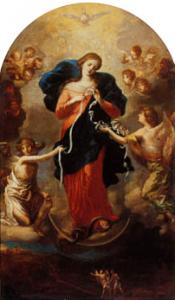
Queen of heaven and queen of angels are commonplace titles of Our Lady. But imagery of the Mother of God trampling on Satan is very old, and the title “Empress of Hell” speaks to that reality; apparently the phrase goes back to St. Alphonsus Liguori. Hell itself has been placed under her feet, as it is beneath her Son’s, and even in calling her the queen of angels, we implicitly say that she has authority over demons, who are after all nothing but evil angels. Halloween itself is, among other things, a ridicule of demons and witchcraft, turning them into a game and an entertainment and a joke, because, as St. Thomas More said, “The prowde spirit cannot endure to be mocked.”


